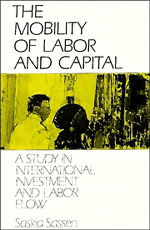Book contents
- Frontmatter
- Contents
- List of tables
- Acknowledgements
- Introduction
- 1 Foreign investment: a neglected variable
- 2 The use of foreign workers
- 3 The new immigration
- 4 The globalization of production: implications for labor migration
- 5 The rise of global cities and the new labor demand
- 6 The reconcentration of capital in the United States: a new investment zone?
- Conclusion
- Notes
- References
- Index
- Frontmatter
- Contents
- List of tables
- Acknowledgements
- Introduction
- 1 Foreign investment: a neglected variable
- 2 The use of foreign workers
- 3 The new immigration
- 4 The globalization of production: implications for labor migration
- 5 The rise of global cities and the new labor demand
- 6 The reconcentration of capital in the United States: a new investment zone?
- Conclusion
- Notes
- References
- Index
Summary
Capital mobility has created new conditions for the mobility of labor. Economic practices and technology have contributed to the formation of a transnational space for the circulation of capital. Policies, many originating in the United States, delimit, regulate and make this space viable. What economic theory as well as governments define as movement between countries is also movement within one single entity encompassing those countries. The central question organizing the inquiry in this book concerns the impact of such a transnational space for the circulation of capital on the formation and directionality of international labor migrations.
This is a new version of an old question. In the late nineteenth century some of the leading political economists debated the impact of free trade on the international movement of labor and capital. Eighteenth-century free trade theory rested on the assumption of international factor immobility; the international circulation of commodities was seen as a process separate from the mobility of capital and labor. These were considered to have mobility only within a country. The transformations brought about by international trade were to be absorbed by the internal mobility of labor and capital across classes and across occupations. The movement of capital and labor from England to its overseas territories was seen as part of the colonization process and, unlike free trade, requiring state regulation.
- Type
- Chapter
- Information
- The Mobility of Labor and CapitalA Study in International Investment and Labor Flow, pp. 1 - 11Publisher: Cambridge University PressPrint publication year: 1988



